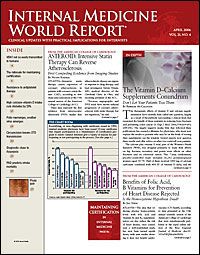Publication
Article
GAIT: What Should You Recommend for Osteoarthritis?
Author(s):
Many Americans take glucosa?mine and chondroitin sulfate to relieve the aches and pains of arthritis and knee osteoarthritis (OA). The Glucosamine/chondroitin Arthritis Intervention Trial (GAIT) tested the efficacy and safety of these 2 supplements, alone and in combination, for the treatment of OA of the knee (N Engl J Med. 2006;354:795-808).
Sponsored by the National Institutes of Health, the 4-week GAIT randomly assigned 1583 patients with knee OA to 5 groups: 1500 mg glucosamine; 1200 mg of chondroitin; both agents in combination; 200 mg celecoxib (Celebrex); or placebo. Mean age of the patients was 59 years; 64% were women. Participants were allowed to take acetaminophen as rescue analgesia.
The primary outcome measure was a 20% reduction in knee OA pain from baseline, as measured by the Western Ontario and McMaster Universities Osteoarthritis Index (WOMAC). Gluco?samine and chondroitin, either alone or in combination, proved to be only slightly more effective than ?placebo. Response rates for the different treatments were: placebo, 60.1%; ?glucosamine, 64%; chondroitin sulfate, 65.4%; both agents combined, 66.6%; and celecoxib, 70.1%.
But in a select few…
However, in the subgroup of patients (n = 354) with moderate-to-severe pain, combined therapy with glucosa?mine and chondroitin was significantly more effective than placebo in achieving a 20% reduction in WOMAC pain score. In this group, response rates were 79.2% with glucosamine plus chondroitin, 69.4% with celecoxib, 65.7% with glucosamine, 61.4% with chondroitin, and 54.3% with placebo. Although those with moderate-to-severe pain constituted only 22% of the study population, results in this group did demonstrate benefits with combination therapy and celecoxib.
Other interesting outcomes include a significant decrease in joint swelling, effusion, or both with chondroitin therapy, and the lack of any increase in ischemic cardiovascular events in all patients taking celecoxib and in patients with diabetes taking glucosamine. The authors caution, ?how?ever, that their study was not powered to assess risk of ischemic cardiovascular events. Lead investigator Daniel O. Clegg, MD, of the Utah School of Medicine, Salt Lake City, and colleagues stress that further research is needed and that patients should be educated about the important fact that celecoxib seems to provide much faster symptom relief than glucosamine and/or chondroitin.
What to tell your patients?
Commenting on GAIT, Marc C. Hochberg, MD, MPH, of the Uni?ver?sity of Maryland School of Med?icine, Baltimore (N Engl J Med. 2006;354:858), offers this advice to physicians: Tell patients who choose to take supplements to use glucosamine and chondroitin in combination for at least 3 months. If there is no improvement, stop taking them. He believes that 3 months is long enough for these ?slow-acting agents to demonstrate an ability to relieve symptoms. He emphasized that patients should take glucosamine sulfate, not glucosa??mine hydrochloride (the study drug).






